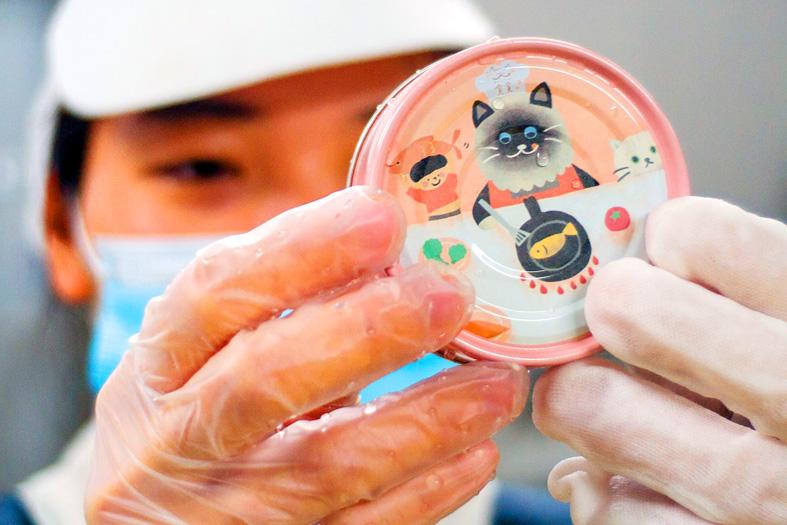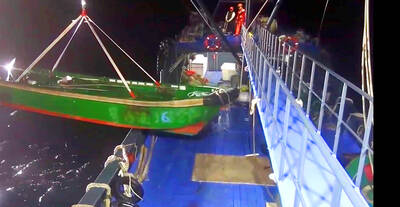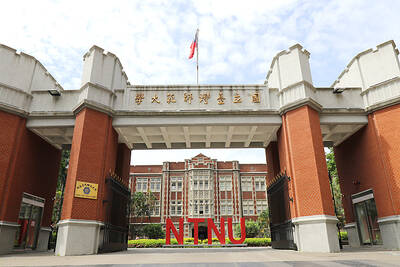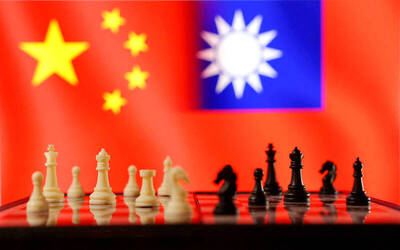Licking its lips imperiously, a ginger cat mops up every last morsel of food from its curly whiskers, clearly undaunted by its supper’s rather unusual base ingredient — silkworm pupae.
The 15 feline residents of the Mao Thai Thai (貓泰泰) cat cafe in New Taipei City’s Linkou District (林口) are among volunteer taste testers sampling a new cat food developed by silkworm experts.
As well as making use of what was previously just a byproduct of silk production, the scientists say the food eliminates harmful intestinal bacteria — with the added bonus of reducing the odor of the cats’ own byproducts.

Photo: Sam Yeh, AFP
“They have more energy and less smelly feces, which is more than I expected,” cafe manager Rosa Su said.
The food comes in normal-sounding flavors — tuna, milkfish, beef and chicken — but the main protein component is insects.
That does not seem to bother Su’s cats, who clamor around her, impatient for their dinner.

Photo: Sam Yeh, AFP
The research team said that much of the feedback from other owners involved in the trial has been positive, too.
At the Council of Agriculture’s century-old Miaoli District Agricultural Research and Extension Station, where the food was created, hundreds of caterpillars wriggle around in trays munching on mulberry leaves.
The facility houses 136 silkworm varieties from all over the world.
The pupa is the intermediate stage in their lifecycle, when they form a cocoon to transition from larva to adult.
“When we see silkworms, we think of silk fabrics,” researcher Liao Chiu-hsun said as she carefully sliced the top off a silk cocoon to extract a squirming brown grub. “But these highly domesticated insects have a lot more to offer.”
The pupae are rich in protein, fat and minerals, but the research team has developed a technique to boost their content of immune proteins that kill harmful bacteria inside the host.
Stressing the silkworms and making them think they are in danger means that they produce more of these proteins in the cocoon, after which they are harvested and turned into cat food.
This innovative use of what was previously mainly a waste product could also be a potential lifeline for the nation’s remaining silkworm farmers. They once numbered in the hundreds, but nowadays only two are still in business.
Third-generation farmer Hsu Wei-chun, 30, said that it is no longer economically feasible to cultivate the insects for fabric alone.
However, mulberry leaves are used to make tea, and cocoons can be used in cosmetics.
“Our competitiveness comes from the ability to use everything,” Hsu said. “We make use of every portion to keep costs down.”
The pet food market presents a lucrative opportunity — animal ownership in the nation is on the rise, and the economy around it is valued at more than US$1 billion.
A can of the silkworm cat food sells for NT$68, a little more than average canned wet food.
“Even though it’s a bit more expensive ... I feel the acceptance level for sustainable and eco-friendly canned food is quite high in Taiwan,” said Lee Wei-ting, department head of Cultural Creativity and Digital Marketing at National United University.
Pet stores in South Korea, Japan, Thailand and the US have expressed interest in the product as well.
The CEO of the company that started mass producing the new food a month ago said that the response has been overwhelming.
“I feel pet owners nowadays are more focused on ingredients,” Eva Liu said. “We used crowdfunding in the beginning as a pre-sale. On the first day, within 24 hours we reached our preliminary goal.”

Taiwan yesterday condemned the recent increase in Chinese coast guard-escorted fishing vessels operating illegally in waters around the Pratas Islands (Dongsha Islands, 東沙群島) in the South China Sea. Unusually large groupings of Chinese fishing vessels began to appear around the islands on Feb. 15, when at least six motherships and 29 smaller boats were sighted, the Coast Guard Administration (CGA) said in a news release. While CGA vessels were dispatched to expel the Chinese boats, Chinese coast guard ships trespassed into Taiwan’s restricted waters and unsuccessfully attempted to interfere, the CGA said. Due to the provocation, the CGA initiated an operation to increase

CHANGING LANDSCAPE: Many of the part-time programs for educators were no longer needed, as many teachers obtain a graduate degree before joining the workforce, experts said Taiwanese universities this year canceled 86 programs, Ministry of Education data showed, with educators attributing the closures to the nation’s low birthrate as well as shifting trends. Fifty-three of the shuttered programs were part-time postgraduate degree programs, about 62 percent of the total, the most in the past five years, the data showed. National Taiwan Normal University (NTNU) discontinued the most part-time master’s programs, at 16: chemistry, life science, earth science, physics, fine arts, music, special education, health promotion and health education, educational psychology and counseling, education, design, Chinese as a second language, library and information sciences, mechatronics engineering, history, physical education

The Chinese military has boosted its capability to fight at a high tempo using the element of surprise and new technology, the Ministry of National Defense said in the Quadrennial Defense Review (QDR) published on Monday last week. The ministry highlighted Chinese People’s Liberation Army (PLA) developments showing significant changes in Beijing’s strategy for war on Taiwan. The PLA has made significant headway in building capabilities for all-weather, multi-domain intelligence, surveillance, operational control and a joint air-sea blockade against Taiwan’s lines of communication, it said. The PLA has also improved its capabilities in direct amphibious assault operations aimed at seizing strategically important beaches,

‘MALIGN PURPOSE’: Governments around the world conduct espionage operations, but China’s is different, as its ultimate goal is annexation, a think tank head said Taiwan is facing a growing existential threat from its own people spying for China, experts said, as the government seeks to toughen measures to stop Beijing’s infiltration efforts and deter Taiwanese turncoats. While Beijing and Taipei have been spying on each other for years, experts said that espionage posed a bigger threat to Taiwan due to the risk of a Chinese attack. Taiwan’s intelligence agency said China used “diverse channels and tactics” to infiltrate the nation’s military, government agencies and pro-China organizations. The main targets were retired and active members of the military, persuaded by money, blackmail or pro-China ideology to steal